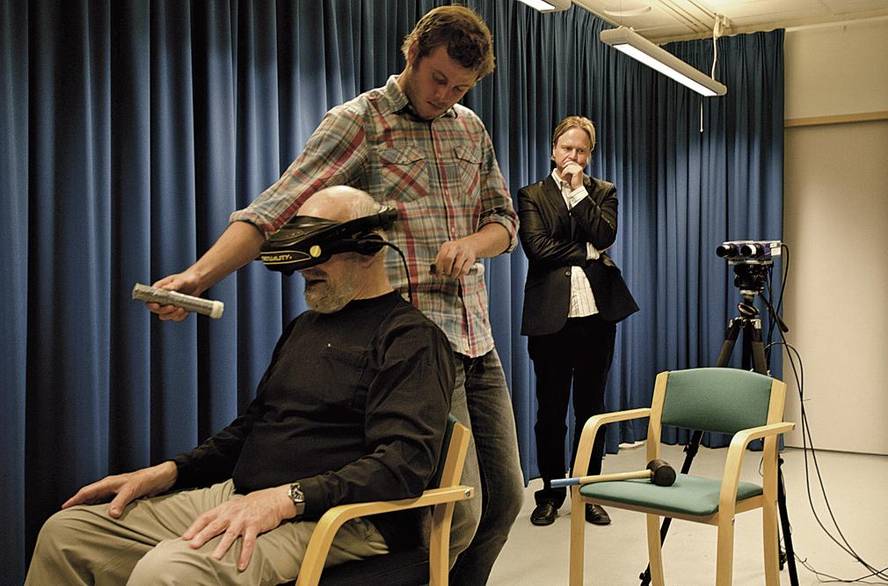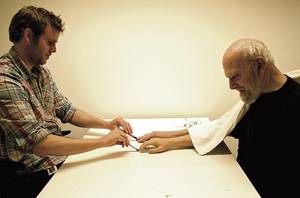Caught in the body of a barbie
Henrik Ehrsson leads the laboratory called Brain, body & self. Although the name of the laboratory may have an esoteric tone, the fact that it is within the Department of Neuroscience of the Karolinska Institute raises all suspicions. In addition, it is true that Ehrsson's research is striking and, like the illusionists, behave with representations, but the methodology he uses is totally scientific and the results he obtains are very useful to understand how the interaction between the brain, the body and the environment occurs and to know the capacity and limits of perception.
As Ehrsson explains, his research in his laboratory aims to know how and why we feel "our body is ours". Rarely does this concern arise as we normally have no doubt that we move the part of the body we want to move or just feel like owners of our body. But in some diseases or confusions there are interruptions between the body and the head. For example, some dying people who have returned to life say they have seen themselves floating on their own bodies, while some neurological patients have had similar experiences. Another example is the ghost limb, in which the patient feels pain in a lost limb. These examples show that direct awareness of one's body is not intrinsic, but constructed.
Thus, Ehrsson and his collaborators seek to know how this consciousness is built. Specifically, they want to know how the central nervous system separates and unites the signals from the body and those that reach it from the environment. In addition, they want to identify the multisentsorial mechanisms that it uses for this purpose.
To this end, volunteering uses neuroimaging, electrophysiology and behavioral techniques. In the long run, it intends to create a "personal representation model." But they do not rule out clinical and industrial applications. According to Ehrsson, the projection of oneself in external objects opens a new path, among others, in the interaction between man and machine, in robotics and in computer science.
Cheating the brain
Ehrsson's research line became popular in 2007 thanks to an article published in the prestigious scientific journal Science: The experimental induction of out-of-body experiences.
In this article, Ehrsson demonstrated that it was possible to create the illusion of feeling out of the body in healthy volunteers. This meant demonstrating the influence of perceptions on the feeling of being located in the body, especially the visual perspective and the multisensory excitations of the body.
The experiment described in the article consisted of two parts. In the first he used two cameras, glasses with images and two rods. The volunteer sat in a chair and the double camera was behind them, two meters behind. The cameras collected the images of the volunteer from behind and projected them into the glasses. Thus, the volunteers saw themselves as if they were behind their bodies.
Along with this, Ehrsson also used tactile stimuli to endanger the relationship between the brain and the body: next to a stick touching the volunteer's chest, he pretended to touch with the other stick the volunteer's virtual body, which was two meters behind. In this way, the volunteer saw the cane touching the body behind himself and felt that he touched the chest.
In this situation, the volunteers stated that they felt outside the body and that the illusion was totally real. To demonstrate the strength and authenticity of the sensation, Ehrsson took advantage of the second part of the experiment: he pretended to hammer the volunteer's virtual body. The result was that the volunteer was deeply frightened and this was demonstrated by the sensors that put him to measure the conductivity of the skin.
An experiment led by Ehrsson to make you feel outside your body. Image: Ola Danielsson/Karolinska Institutua.
According to Ehrsson, this experiment provides the "basic information" of the process of feeling within the body itself. On the one hand, it demonstrates that visual information is essential to know the position of our body with respect to the environment, and that this information is key to adjusting the perception that is received from the proprioceptive system (the proprioceptive system is the signal that sends the skin, muscles and joints to know the relative position of the body). On the other hand, it shows that the synchronization of multisentsorial and visual signals is sufficient to induce the sensation of being outside the body itself.
Rubber hands and mannequins
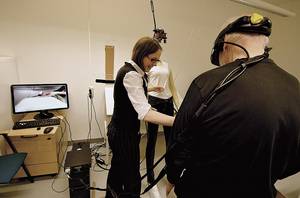
Since then, Ehrsson has continued to design and conduct experiments to deepen this field. For example, he has created the "illusion of the rubber hand" and of owning three hands.
In both cases it has used prosthetic arms, similar to the real ones. In the first, he hid the volunteer's right arm behind a screen and instead exposed the rubber arm. Then he rubbed the two arms, rubber and really, at the same time with a brush. Thus, the volunteer felt the tactile sensation at the same time that he saw rubbed the rubber arm. Consequently, he considered that he had his rubber arm.
In addition, he showed that it was necessary that the touches were synchronous so that the imagination was strong, otherwise the volunteer realizes the trick and does not believe that he has a rubber arm of his. The same happens if instead of being straight the arm rotates 90-180º.
The feeling of possession of three hands is similar, but in this case it did not hide the right hand of the volunteer, but left them in sight. Then he touched both hands at once with the brush. It is logical to think that the brain will separate the stimuli collected in its arm from one of those made in the rubber arm, which does not occur and admits that it has three arms.
Experiment to feel the possession of three arms. Image courtesy of: Kjell Erlandsson/Karolinska Institute.
This experiment involved 154 healthy volunteers who demonstrated that the prosthetic arm was his, a researcher threatened the prosthetic arm with a kitchen knife. The physiological response of the volunteers was similar to that given when they threatened the real arm: they felt fear and stress.
The Ehrsson team took another step and, while the volunteers were imagined, analyzed the activity of their brain using MRI. Thus, it was observed that the activity of the multisensory brain areas intensified by having the sensation of having three hands, for example, in the premotor and parietal cortex, and that the activity was directly related to the solidity of the imagination.
The researchers noted that the results of the study may serve to improve the sensations of patients who will use prostheses and treat phantom limb syndrome.
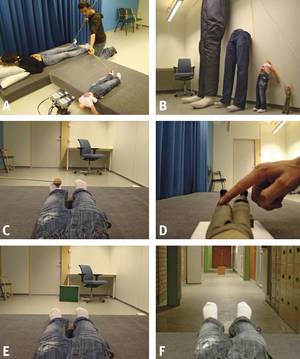
After these experiments, Ehrsson went further: if he accepted that the brain was outside his body and that he owned three arms, did he accept being inside another body? To prove it he used a mannequin.
At the head of the mannequin he put two cameras. As if they were the eyes of the mannequins, the cameras received images about the mannequin. The volunteers were put on glasses with screen, which are the ones that have seen the eyes of the mannequin that was projected on those screens (that is, the cameras).
Thanks to this trick, the volunteers saw the mannequin's body as their own. However, this feeling was much stronger when tactile stimuli were received: just as in the illusion of the hand, Ehrsson played at the same time the mannequin and the volunteer's body, and then yes, the volunteers were trapped inside the mannequin's body.
pair Alice
However, not all volunteers believe in fraud. For Ehrsson, people who have great control over limbs, such as dantzaris or musicians, are more credible than students who participate in their experiments. However, the brain incites four out of five.
In his latest research, Ehrsson has analyzed the influence of body size on perception of the environment and published the results in the article titled Being Barbie: the size of one´s own body determines the perceived size of the world.
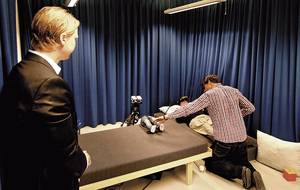
From the traditional point of view, our perception of the environment is conditioned by the vision and structure and functioning of the eye. Some researchers have proposed an ecological approach. They consider that one's interaction with the environment also partly influences the perception of the environment.
To demonstrate the importance of body measurement within this second hypothesis, Ehrsson has conducted a series of experiments based on the mannequin experiment. For this purpose he has used dolls of different sizes: A barbie, a doll of 80 cm, one of 180 cm and one of 400 cm.
Barbie has used it to see if it is possible to create the feeling of having a body as small as the doll. And yes, as in the experiment of the mannequin, after having received visual and tactile stimuli, the volunteers have believed that they are the size of a Barbie. According to them, the feeling was not that they were small, but that the world around them was great.
With the dolls of the other three measures he has shown that this imagination is real. Depending on the size of the doll - both the body itself and the size feel -, the volunteers consider that the environment is more or less large: if each one is 80 cm long, and very small if it is 4 meters.
Experiment to make us feel like the doll. Image courtesy of: Ola Danielsson and Henrik Ehrsson.
In the article, Ehrsson also mentions the possible applications of research. In his opinion, he opens an interesting path to take on humanoid robots and simulated bodies. For example, a surgeon may look at the place of a microrobot and operate as if it were inside the patient's body. Or an engineer can feel that it is a gigantic humanoid robot and with that imagination repair the oil platform of the seabed.
Applications seem science-fiction, but believing someone who has three arms was not easy. Meanwhile, Ehrsson continues his experiments.



